Elsevier Encyclopedia of Geology - vol I A-E
Подождите немного. Документ загружается.

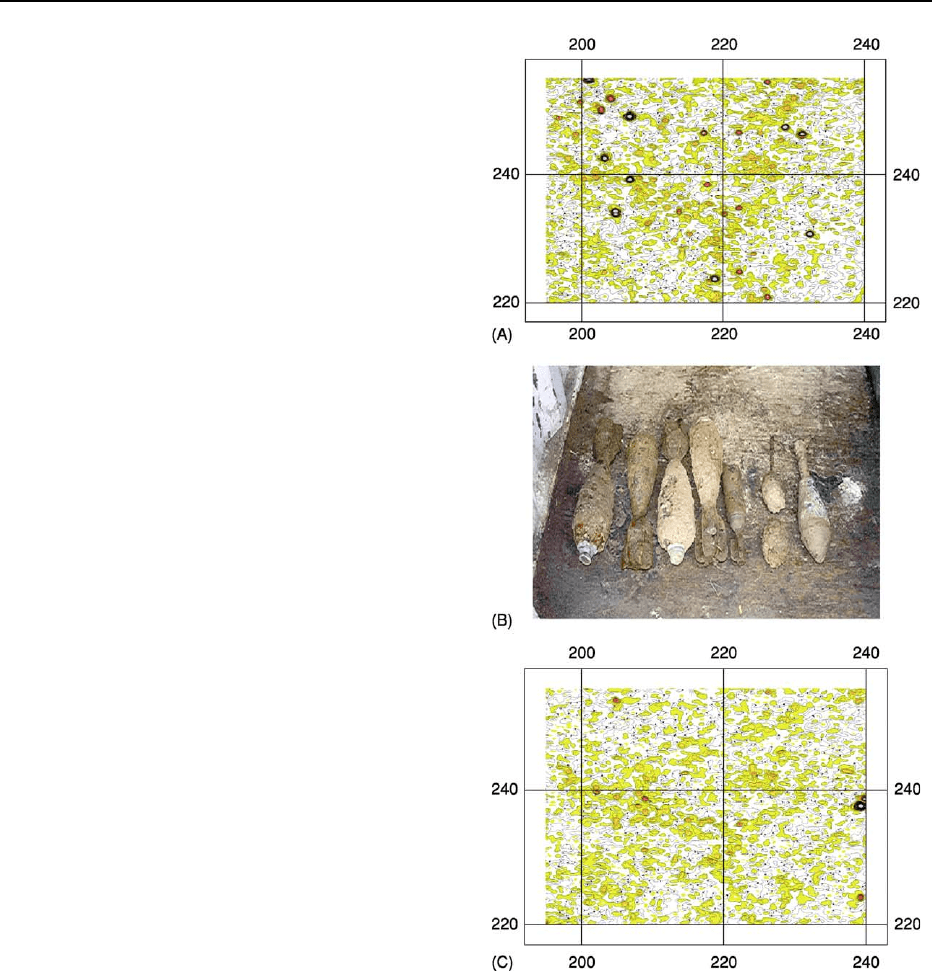
munitions-factory sites, military bases, military
training grounds, and wartime target areas. Apart
from low-metal landmines, most ordnance is com-
posed of metal casing, which can be targeted by geo-
physical methods (depending on the size and depth of
burial). In London, UK, which was heavily bombed
during the Second World War, there may be a risk of
the presence of unexploded bombs to depths of 10 m
or more, depending on the size of bomb dropped and
soil conditions. Deep bombs such as these are un-
detectable using surface geophysical methods but
can be detected using sensors lowered down bore-
holes or mounted in push rods. An example of how
geophysics can be used to mitigate the risk posed by
unexploded ordnance is shown in Figure 16. A site-
wide gradient magnetometer survey was carried out
on a close grid spacing to detect small ferrous ord-
nance items. These were then flagged in the field for
identification and disposal. Following removal of
identified targets a second survey was carried out to
confirm that all located ordnance had been removed.
Non-Destructive Testing
Engineering geophysics forms a significant compon-
ent of the field of non-destructive testing, which en-
compasses all methods used to detect and evaluate the
integrity of materials. Non-destructive testing is used
for in-service inspection and condition monitoring of
structures and plant including the measurement of
physical properties such as hardness and internal
stress.
Examples of geophysical methods used in non-
destructive testing are tabulated in Table 4.
Containment Structures
As well as playing a role in the assessment of ground
conditions prior to construction of a containment
structure such as a lagoon or dam, geophysics can
also be used to effect in the assessment and monitor-
ing of the integrity of a structure prior to and during
use and in the investigation of breaches in contain-
ment during its lifetime. In the latter case, where the
storage of hazardous materials such as chemical and
nuclear wastes is involved, a geophysical survey is
often a cost-effective means of investigating the
problem as it avoids the need to remove the stored
material.
The most common requirement for geophysics at
the pre-commissioning stage is in the assessment of
the integrity of lined structures such as domestic land-
fills and leachate lagoons using the electrical leak
location method. This technique originated in the
USA during the mid-1980s and has since been
adopted widely. It now forms a recommended part
of the Construction Quality Assurance testing of new
landfill cells in the UK. The technique comprises a
novel form of resistivity profiling, which takes ad-
vantage of the insulating properties of geomem-
brane materials, such as HDPE (high density
polyethylene) and PVC (polyvinyl chloride), in order
to pinpoint holes or tears as small as 0.5 mm
2
. Vari-
ants of the basic method have been developed for
testing soil-covered liners, cell side slopes (with no
cover material), and water-filled lagoons and ponds.
Figure 16 (A) The results of scanning an area using gradient
magnetic profiling to detect ferrous ordnance items. (B) The lo-
cated items were removed by trained EOC (Explosive Ordnance
Clearance) personnel, and (C) the area was rescanned to prove
that all items had been removed.
496 ENGINEERING GEOLOGY/Geophysics

Permanent geomembrane electrical leak location
systems, comprising a grid of electrodes below or on
either side of the geomembrane, allow continuous
monitoring of the integrity of the liner throughout its
lifetime. These systems can also be employed to create
two- or three-dimensional resistivity models for the
strata beneath the containment in order to monitor
the spread of pollutants in the event of a breach.
Where access to a structure is unavailable or im-
possible owing to the hazardous nature of the con-
tents, the structure can be monitored remotely using
techniques such as electrical resistance tomography
and excitation of the mass. Unlike electrical leak
location, these methods also enable the detection of
leaks from conductive containment structures such
as steel underground storage tanks. Both methods
involve the use of an array of electrodes placed
around the structure, with excitation of the mass
additionally employing an electrode placed within
the containment.
Investigations into breaches in containment struc-
tures such as dams, locks, and canals can involve a
wide variety of geophysical techniques, depending on
the nature of the problem. Methods such as GPR and
sonic testing can be used to identify voiding within
and behind concrete and brick structures, whilst re-
sistivity imaging might be used to map changes in
electrical resistivity resulting from the outflow of
water from a dam or canal. The self-potential method
involves measuring low-amplitude voltages that
result from the movement of fluids through soil and
rock and can be used to locate seepage pathways
within embankments and retaining walls.
Buried Assets
The inaccuracy and incompleteness of site plans
showing services is infamous. Failing to confirm the
location of underground services and other assets,
such as underground storage tanks, can have serious
cost and safety implications for a project. In the
UK, the requirement to locate services prior to the
commencement of any intrusive work has now been
included in Health and Safety legislation. Confirm-
ation of the position and depth of existing utility lines
during the site-investigation phase allows for the
planned diversion of essential services and ensures
that exploratory boreholes and trial pits can be safely
positioned.
The detection and tracing of services presents a
particular problem for geophysics owing to the range
of materials and target sizes that can be encountered.
For this reason it is common to approach services
detection with a broad suite of both passive and active
techniques. Those most commonly used techniques
include continuous-wave electromagnetic profiling
(Figure 17), and passive electromagnetic methods
such as the cable avoidance tool, magnetic profiling,
and GPR (Figure 18). The latter is the only method
capable of detecting non-metallic utility lines such as
high-pressure water and gas mains.
In order to ensure optimum detection of linear
targets such as services it may be necessary to under-
take the survey in two orthogonal directions unless
the majority of the targets are known to trend in a
particular direction. This is particularly important
for electromagnetic profiling and GPR, where the
target response is highly dependent on the relative
orientation of the instrument and target.
Where access to a particular pipe is available
tracing may be simplified by using a pipe sonde.
This comprises an electromagnetic transmitter
mounted in a cylindrical housing that can be fed
into the pipeline through an access cover or outfall.
The signal from the transmitter is detected on the
surface using a suitable hand-held receiver.
It is important to note that the detectability of
services is dependant on burial setting and on the
material type of the services being mapped. For
example, an inaccessible concrete waste pipe 30 cm
in diameter buried more than 2 m deep in clayey soils
could be undetectable with any geophysical method.
Services running beneath reinforced concrete slabs
may be detectable only within 0.5 m of the surface
with GPR as the presence of reinforcing will preclude
Table 4 Geophysical methods used in non-destructive testing (after McDowell et al., 2002)
Material Method Application
Concrete Ultrasonic pulse velocity, GPR Measure strength, voidage, reinforcing, cracking, cover,
and fire damage
Metal Ultrasonic pulse velocity Measure thickness and cracking
Walls and roofs Thermography, GPR, electromagnetic scanners,
resistance/capacitance
Cavity insulation, wall ties, cladding fixings, moisture
penetration, roof leaks
Buried objects GPR, Cable Avoidance tool (CAT), magnetometer Location of services and foundations, archaeological
remains, buried objects
Machinery Vibration metres, thermography, sound metres Worn bearings, overheating (electrical)
ENGINEERING GEOLOGY/Geophysics 497
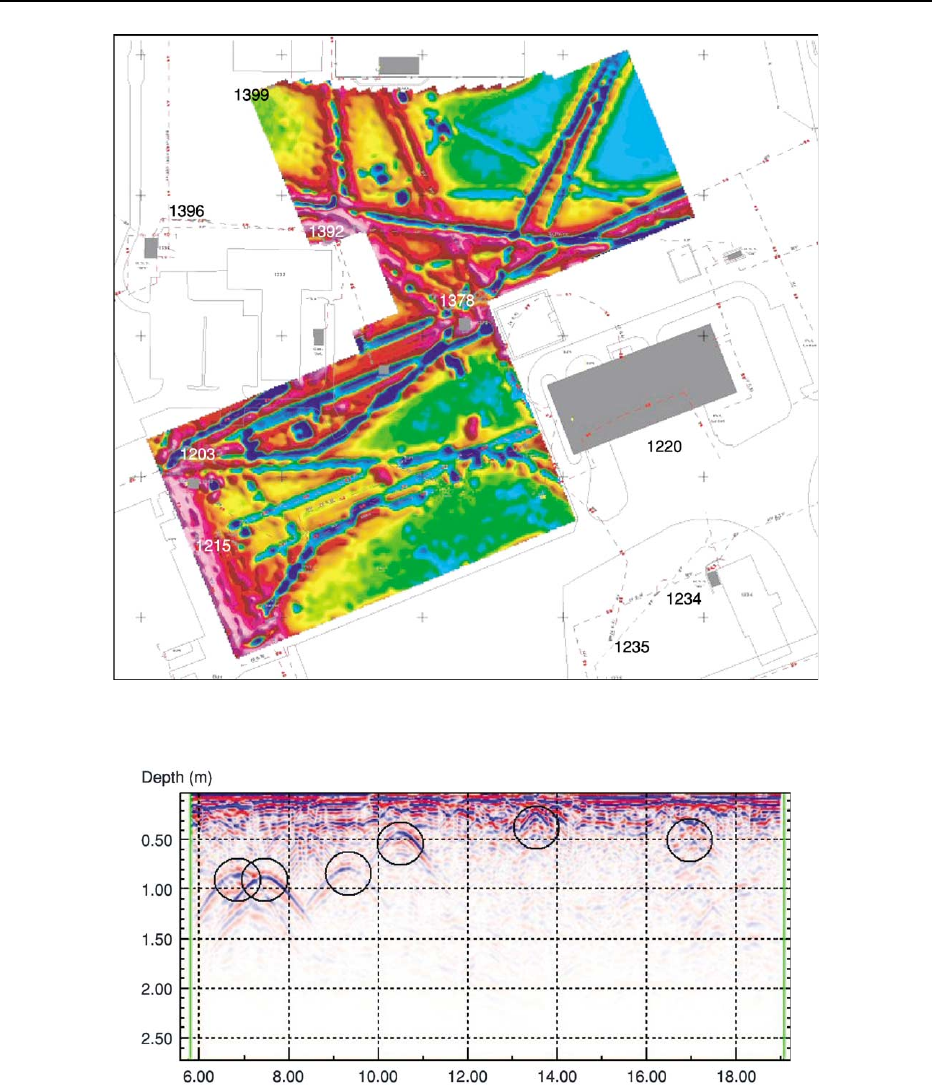
the use of electromagnetic methods. Exaggerated
claims that ‘95% of all buried services will be
mapped’ should be weighed against the limitations
of geophysical methods in general.
Estimating the depth to the top of a target is pos-
sible, although the degree of accuracy varies widely.
Cable-avoidance tools provide a quick method of
determining approximate depths on site, although
these are generally accurate only to within 20%.
Advanced processing of magnetic data using tech-
niques such as Euler Deconvolution or 2.5D inverse
and forward modelling enables estimates of depths
to within 15–20%. In the case of GPR, calculation
of target depths is dependent on determining the
average velocity of the signal through the overlying
materials.
Figure 18 The location of buried utilities using GPR.
Figure 17 Electromagnetic profiling survey to map the location of services at an air base in the UK.
498 ENGINEERING GEOLOGY/Geophysics

See Also
Analytical Methods: Gravity. Engineering Geology:
Seismology; Natural and Anthropogenic Geohazards;
Site and Ground Investigation; Site Classification. Mili-
tary Geology. Rock Mechanics. Seismic Surveys. Soil
Mechanics.
Further Reading
Environmental and Engineering Geophysical Society. http://
www.eegs.org/whatis/
Health and Safety Executive (UK) (2000) Avoiding Danger
from Underground Services. Health and Safety
Executive, London.
McCann DM, Eddleston M, Fenning PJ, and Reeves GM
(eds.) (1997) Modern Geophysics in Engineering
Geology. Engineering Geology Special Publication 12.
London: Geological Society.
McDowell PW, Barker RD, and Butcher AP (eds.)
(2002) Geophysics in Engineering Investigations.
Engineering Geology Special Publication 19. London:
CIRIA.
Milsom J (2003) Field Geophysics, 3rd edn., The Geo-
logical Field Guide Series. Chichester: John Wiley &
Sons.
Reynolds JM (1997) An Introduction to Applied and
Environmental Geophysics. Chichester: John Wiley &
Sons.
Telford WM, Geldart LP, and Sheriff RE (1990) Applied
Geophysics, 2nd edn. Cambridge: Cambridge University
Press.
Zeltica. Geophysical Method Descriptons. http://www.
geophysics.co.uk/methods.html
Seismology
J J Bommer, Imperial College London, London, UK
D M Boore, United States Geological Survey, Menlo
Park, CA, USA
ß 2005, Elsevier Ltd. All Rights Reserved.
Introduction
Engineering seismology is an integral part of earth-
quake engineering, a specialized branch of civil en-
gineering concerned with the protection of the built
environment against the potentially destructive effects
of earthquakes. The objective of earthquake engineer-
ing can be stated as the reduction or mitigation of
seismic risk, which is understood as the possibility of
losses – human, social or economic – being caused by
earthquakes. Seismic risk exists because of the convo-
lution of three factors: seismic hazard, exposure, and
vulnerability. Seismic hazard refers to the effects of
earthquakes that can cause damage in the built envir-
onment, such as the primary effects of ground shaking
or ground rupture or secondary effects such as soil
liquefaction or landslides. Exposure refers to the pop-
ulation, buildings, installations, and infrastructure en-
countered at the location where earthquake effects
could occur. Vulnerability represents the likelihood
of damage being sustained by a structure when it is
exposed to a particular earthquake effect.
Earthquake Hazards and
Seismic Risk
Risk can be reduced in two main ways, the first being
to avoid exposure where seismic hazard is high.
However, human settlement, the construction of
industrial facilities, and the routing of lifelines such
as roads, bridges, pipelines, telecommunications, and
energy distribution systems are often governed by
other factors that are of greater importance. Indeed,
for lifelines, which may have total lengths of hun-
dreds of kilometres, it will often be impossible to
avoid seismic hazards by relocation. Millions of
people are living in areas of the world where there is
appreciable seismic hazard. The key to mitigating
seismic risk therefore lies in control of vulnerability
in the built environment, by designing and building
structures and facilities with sufficient resistance
to withstand the effects of earthquakes; this is the
essence of earthquake engineering.
This is not to say, however, that the aim is to
construct an earthquake-proof built environment
that will suffer no damage in the case of a strong
earthquake. The cost of such levels of protection
would be extremely high, and, moreover, it might
mean protecting the built environment against events
that may not occur within the useful life of a particu-
lar building. It is generally not possible to justify such
investments, especially when there are many compet-
ing demands on resources. Objectives of earthquake-
resistant design are often stated in terms that relate
different performance objectives to different levels of
earthquake motion, such as no damage being sus-
tained due to mild levels of shaking that may occur
frequently, damage being limited to non-structural
elements or to easily repairable levels in struc-
tural elements in moderate shaking that occurs occa-
sionally, and collapse being avoided under severe
ENGINEERING GEOLOGY/Seismology 499
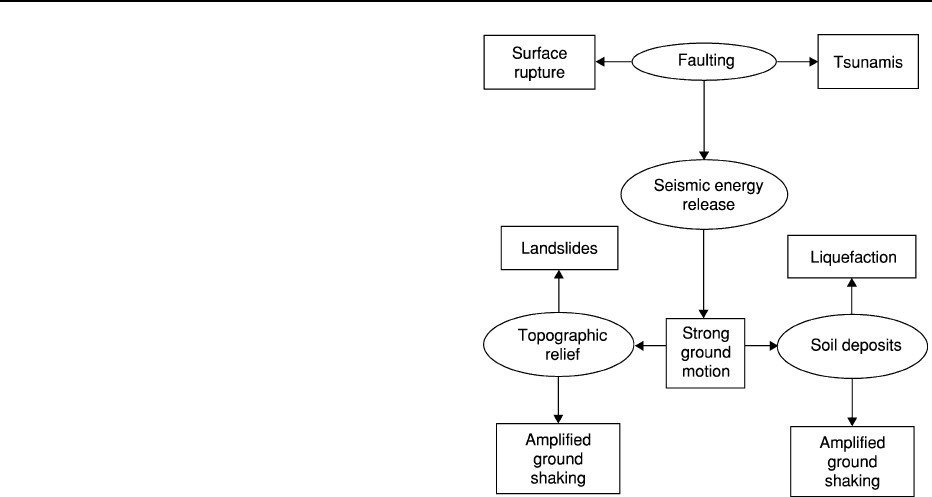
ground shaking that is only expected to occur rarely.
These objectives are adjusted according to the conse-
quences of damage to the structure; for rare occur-
rences of intense shaking, the performance target for
a single-family dwelling will be to avoid collapse of
structural elements, so that the occupants may escape
from the building without injury. For a hospital or fire
station, the performance target will be to remain fully
operational under the same level of shaking, because
the services provided will be particularly important in
the aftermath of an earthquake. For a nuclear power
plant or radioactive waste repository, the perform-
ance objective will be to maintain structural integrity
even under extreme levels of shaking that may be
expected to occur very rarely.
Once planners and developers have taken decisions
regarding the location of civil engineering projects,
or once people have begun to settle in an area, the
level of exposure is determined. In general, seismic
hazard cannot be altered, hence the key to mitigating
seismic risk levels lies in the reduction of vulnerabi-
lity or, stated another way, depends on the provision
of earthquake resistance. In order to provide effective
earthquake protection, the civil engineer requires
quantitative information on the nature and likeli-
hood of the expected earthquake hazards. As already
indicated, this may mean defining the hazard, not
in terms of the effects that a single earthquake event
may produce at the site, but as a synthesis of the
potential effects of many possible earthquake scen-
arios and quantitative definitions of the particular
effects that may be expected to occur with different
specified frequencies. This is the essence of engineer-
ing seismology: to provide quantitative assessments
of earthquake hazards.
Earthquake generation creates a number of effects
that are potentially threatening to the built envir-
onment (Figure 1). These effects are earthquake
hazards, and engineering seismology, in the broadest
sense, is concerned with assessing the likelihood and
characteristics of each of these hazards and their pos-
sible impact in a given region or at a given site of
interest. Earthquakes are caused by sudden rupture
on geological faults, the slip on the fault rupture
ranging from a few to tens of centimetres for moder-
ate earthquakes (magnitudes from 5 to about 6.5) to
many metres for large events (see Tectonics: Earth-
quakes). In those cases where the fault extends to the
ground surface (which is often not the case), the
relative displacement of the two sides of the fault
presents an obvious hazard to any structure crossing
the fault trace. In the 17 August 1999 Kocaeli earth-
quake in Turkey, several hundred houses and at least
one industrial facility were severely damaged by the
surface deformations associated with the slip on the
North Anatolian fault. However, buildings must be
situated within a few metres of the fault trace for
surface rupture to be a hazard, whereas ground
shaking effects can present a serious hazard even at
tens of kilometres from the fault trace; hence, even if
the fault rupture is tens or even hundreds of kilo-
metres in length, the relative importance of surface
rupture hazard is low. An exception to this is where
lifelines, particularly pipelines, cross fault traces, al-
though identification and quantification of the hazard
allows the design to take into account the expected
slip in the event of an earthquake: in the vicinity of the
Denali Fault, the trans-Alaskan oil pipeline is mounted
on sleepers that allow lateral movement, which
permitted the pipeline to remain functional despite
more than 4 m of lateral displacement on the fault in
the magnitude 7.9 earthquake of 3 November 2002.
Surface fault ruptures in the ocean floor can
give rise to tsunamis, seismic sea waves that are
generated by the sudden displacement of the surface
of the sea and travel with very high speeds. As the
waves approach the shore and the water depth
decreases, the amplitude of the waves increases to
maintain the momentum, reaching heights of up to
30 m. When the waves impact on low-lying coastal
areas, the destruction can be almost total.
All of the other hazards generated by earthquakes
are directly related to the shaking of the ground caus-
ed by the passage of seismic waves. The rapid move-
ment of building foundations during an earthquake
Figure 1 Potentially destructive effects of earthquakes, show-
ing the elements of the earthquake generation process and the
natural environment (ovals) and the resulting seismic hazards
(rectangles).
500 ENGINEERING GEOLOGY/Seismology

generates inertial loads that can lead to damage and
collapse, which is the cause of the vast majority of
fatalities due to earthquakes. For this reason, the
main focus of engineering seismology, and also of
this article, is the assessment of the hazard of ground
shaking. Earthquake ground motion can be amplified
by features of the natural environment, increasing
the hazard to the built environment. Topographic
features such as ridges can cause amplification of
the shaking, and soft soil deposits also tend to in-
crease the amplitude of the shaking with respect to
rock sites. At the same time, the shaking can induce
secondary geotechnical hazards by causing failure of
the ground. In mountainous or hilly areas, earth-
quakes frequently trigger landslides, which can
significantly compound the losses: the 6 March
1987 earthquake in Ecuador triggered landslides
that interrupted a 40-km segment of the pipeline
carrying oil from the production fields in the Amazon
basin to the coast, thereby cutting one of the major
exports of the country; the earthquake that struck El
Salvador on 13 January 2001 killed about 850
people, and nearly all of them were buried by
landslides. In areas where saturated sandy soils are
encountered, the ground shaking can induce lique-
faction (see Engineering Geology: Liquefaction)
through the generation of high pore-water pressures,
leading to reduced effective stress and a significant
loss of shear strength, which in turns leads to the
sinking of buildings into the ground and lateral
spreading on river banks and along coasts. Extensive
damage in the 17 January 1994 Kobe earthquake was
caused by liquefaction of reclaimed land, leaving
Japan’s second port out of operation for 3 years.
The assessment of landslide and liquefaction
hazard involves evaluating the susceptibility of slopes
and soil deposits, and determining the expected level
of earthquake ground motion. The basis for earth-
quake-resistant design of buildings and bridges also
requires quantitative assessment of the ground
motion that may be expected at the location of the
project during its design life. Seismic hazard assess-
ment in terms of strong ground motion is the activity
that defines engineering seismology.
Measuring Earthquake
Ground Motion
The measurement of seismic waves is fundamental to
seismology. Earthquake locations and magnitudes are
determined from recordings on sensitive instruments
(called seismographs) installed throughout the world,
detecting imperceptible motions of waves generated
by events occurring hundreds or even thousands of
kilometres away. Engineering seismology deals with
ground motions sufficiently close to the causative
rupture to be strong enough to present a threat to
engineering structures. There are cases in which
destructive motions have occurred at significant dis-
tances from the earthquake source, generally as the
result of amplification of the motions by very soft soil
deposits, such as in the San Francisco Marina District
during the 18 October 1989 Loma Prieta earthquake,
and even more spectacularly in Mexico City during the
19 September 1985 Michoacan earthquake, almost
400 km from the earthquake source. In general, how-
ever, the realm of interest of engineering seismology is
limited to a few tens of kilometres from the earthquake
source, perhaps extending to 100 km or a little more
for the largest magnitude events.
Seismographs specifically designed for measuring
the strong ground motion near the source of an earth-
quake are called accelerographs, and the records that
they produce are accelerograms. The first accelero-
graphs were installed in California in 1932, almost
four decades after the first seismographs, the delay
being caused by the challenge of constructing instru-
ments that were simultaneously sensitive enough to
produce accurate records of the ground acceleration
while being of sufficient robustness to withstand the
shaking without damage.
Prior to the development of the first accelero-
graphs, the only way to quantify earthquake shaking
was through the use of intensity scales, which provide
an index reflecting the strength of ground shaking at a
particular location during an earthquake. The index
is evaluated on the basis of observations of how
people, objects, and buildings respond to the shaking
(Table 1). Some intensity scales also include the re-
sponse of the ground with indicators such as slump-
ing, ground cracking, and landslides, but these
phenomena are generally considered to be dependent
on too many variables to be reliable indicators of
the strength of ground shaking. At the lower intensity
degrees, the most important indicators are related to
human perception of the shaking, whereas at the
higher levels, the assessment is based primarily on
the damage sustained by different classes of buildings.
A common misconception is that intensity is a meas-
ure of damage, whereas it is in fact a measure of the
strength of ground motion inferred from building
damage, whence a single intensity degree can corres-
pond to severe damage in vulnerable rural dwellings
and minor damage in engineered constructions. The
most widely used intensity scales, both of which have
12 degrees and which are broadly equivalent, are the
Modified Mercalli (MM), used in the Americas, and
the 1998 European Macroseismic Scale (EMS-98),
which has replaced the Medvedev–Sponheuer–Karnik
(MSK) scale.
ENGINEERING GEOLOGY/Seismology 501

A very useful picture of the strength and distribu-
tion of ground shaking in an earthquake can be
obtained by mapping intensity observations. The
modal value is assigned to each given location, such
as a village, from all the individual point observations
gathered, and then lines called isoseismals are drawn
to enclose areas where the intensity reached the same
degree (Figure 2). Such isoseismal maps have many
applications, one of the most important of which is to
establish correlations between earthquake size (mag-
nitude) and the area enclosed by isoseismals. These
empirical relations can then be used to estimate the
magnitude of historical earthquakes that occurred
before the advent of the global seismograph network
at the end of nineteenth century, but for which it is
possible to compile isoseismal maps from written
accounts of the earthquake effects. For engineering
design and analysis, however, intensity values are of
limited use because they cannot be reliably translated
into numerical values related to the acceleration or
displacement of the ground. Indeed, intensities are
usually expressed in Roman numerals precisely to
reinforce the idea that they are broad indices rather
than numerical measurements. This is why accelero-
grams are invaluable to earthquake engineering, pro-
viding detailed measurements of the actual movement
of the ground during strong earthquake-induced
shaking.
Accelerograms generally consist of three mutually
perpendicular components of motion, two horizontal
and one vertical, registering the ground acceleration
against time (Figure 3). The first generation of accel-
erographs produced analogue records on paper or
film, which had to be digitized in order to be able to
perform numerical analyses. The analogue recording
and the digitization process both introduce noise into
the signal; this noise then requires processing of the
time-series to improve the signal-to-noise ratio, par-
ticularly at long periods. This processing generally
involves the application of digital filters. The current
models of accelerographs record digitally, thus by-
passing the time-consuming and troublesome process
of digitization, and producing records with much
lower noise contamination. Another advantage of
Table 1 Summary of the 1998 European Macroseismic Scale
Intensity Definition Effects on people and buildings
a
I Not felt Not felt; detected only by sensitive instruments
II Scarcely felt Felt by very few people, mainly those who are in particularly favourable conditions at rest
and indoors
III Weak Felt by a few people, mostly those at rest
IV Largely observed Felt by many people indoors and very few outdoors; a few people are awakened by the shaking
V Strong Felt by most people indoors and a few outdoors; a few people are frightened and many who are
sleeping are awakened by the shaking
Fine cracks in a few of the most vulnerable types of buildings, such as adobe and unreinforced
masonry
VI Slightly damaging Shaking felt by nearly everyone indoors and by many outdoors; a few people lose their balance
Minor cracks in many vulnerable buildings and in a few poor-quality RC structures; a few of the
most vulnerable buildings have cracks in walls and spalling of fairly large pieces of plaster
VII Damaging Most people are frightened by the shaking, and many have difficulty standing, especially those on
upper storeys of buildings
Many adobe and unreinforced masonry buildings sustain large cracks and damage to roofs and
chimneys; some will have serious failures in walls and partial collapse of roofs and floors;
minor cracks in RC structures with some earthquake-resistant design, more significant cracks
in poor-quality RC structures
VIII Heavily damaged Many find it difficult to stand
Many vulnerable buildings experience partial collapse and some collapse completely; large and
extensive cracks in poor-quality RC buildings and many cracks in RC buildings with some
degree of earthquake-resistant design
IX Destructive General panic (this is the highest degree of intensity that can be assessed from human response)
General and extensive damage in vulnerable buildings; cracks in columns, beams, and partition
walls of RC buildings, with some of those of poor quality suffering heavy structural damage and
partial collapse; non-structural damage in RC structures with high level of earthquake-resistant
design
X Very destructive Partial or total collapse in nearly all vulnerable buildings; extensive structural damage in RC and
steel structures
XI Devastating Extensive damage and widespread collapse in nearly all building types; very rarely observed,
if ever
XII Completely
devastating
Cataclysmic damage; has never been observed and is probably not physically realizable
a
RC, Reinforced concrete.
502 ENGINEERING GEOLOGY/Seismology

Figure 2 (A) Regional isoseismal map of the Lisbon earthquake of January 1531. (B) Isoseismal map for the epicentral area of the Lisbon earthquake of January 1531, superimposed on a
map of the local geology. Reprinted with permission from Justo JL and Salwa C (1998) The 1531 Lisbon earthquake.
Bulletin of the Seismological Society of America 88(2): 319–328.
ß Seismological Society of America.
ENGINEERING GEOLOGY/Seismology 503
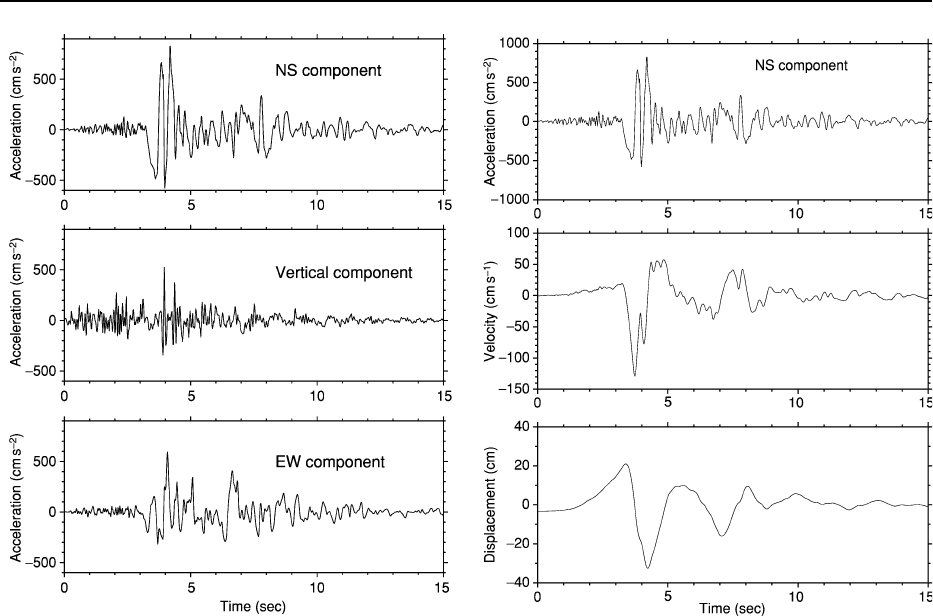
digital accelerographs is that they record continu-
ously on reusable media, whereas optical–mechanical
instruments remain on standby until triggered by a
minimum-threshold acceleration, thus missing the
very first-wave arrivals. Although the motions missed
by an analogue instrument are generally very small,
the advantage with a digital record is that the bound-
ary conditions of initial velocity and displacement are
known with greater confidence; the time-series of
velocity and displacement are obtained by simple
integration of the acceleration time-series, modified
as needed by filtering and/or baseline correction to
account for long-period noise (Figure 4).
Characterizing Strong
Ground Motion
A number of parameters are used to characterize the
nature of the earthquake ground motion captured on
an accelerogram, although in isolation, no single par-
ameter is able to represent fully all of the important
features. The simplest and most widely used param-
eter is the peak ground acceleration (PGA), which is
simply the largest absolute value of acceleration in the
time-series; the horizontal PGA is generally treated
separately from the peak vertical motion. Similarly
the values of the peak ground velocity (PGV) and
peak ground displacement (PGD) are also used to
characterize the motion, although the latter is diffi-
cult to determine reliably from an accelerogram be-
cause of the influence of the unknown baseline on the
records and the double integration of the long-period
noise in the record. These parameters are particularly
poor for characterizing the overall nature of the
motion because they reflect only the amplitude of a
single isolated peak (Figure 5). In engineering seis-
mology, unlike geophysics, accelerations are gener-
ally expressed in units of g, the acceleration due to
gravity (9.81 m s
2
).
Another important characteristic of the ground
motion is the duration of shaking, particularly of
the portion of the accelerogram where the motion is
intense. There are many different ways in which the
duration of the motion can be measured from an
accelerogram, one of the more commonly used defin-
itions being the total interval between the first and last
excursions of a specified threshold, such as 0.05 g.
Duration of shaking is particularly important in
Figure 3 Three-component accelerogram (NS, north–south;
EW, east–west) digitized from an analogue recording at the
Sylmar Hospital free-field site during the Northridge, California,
earthquake of January 1994.
Figure 4 Filtered acceleration, velocity, and displacement
time-series from the north–south (NS) horizontal component of
the Sylmar Hospital free-field site record (1994 earthquake,
Northridge, California).
504 ENGINEERING GEOLOGY/Seismology
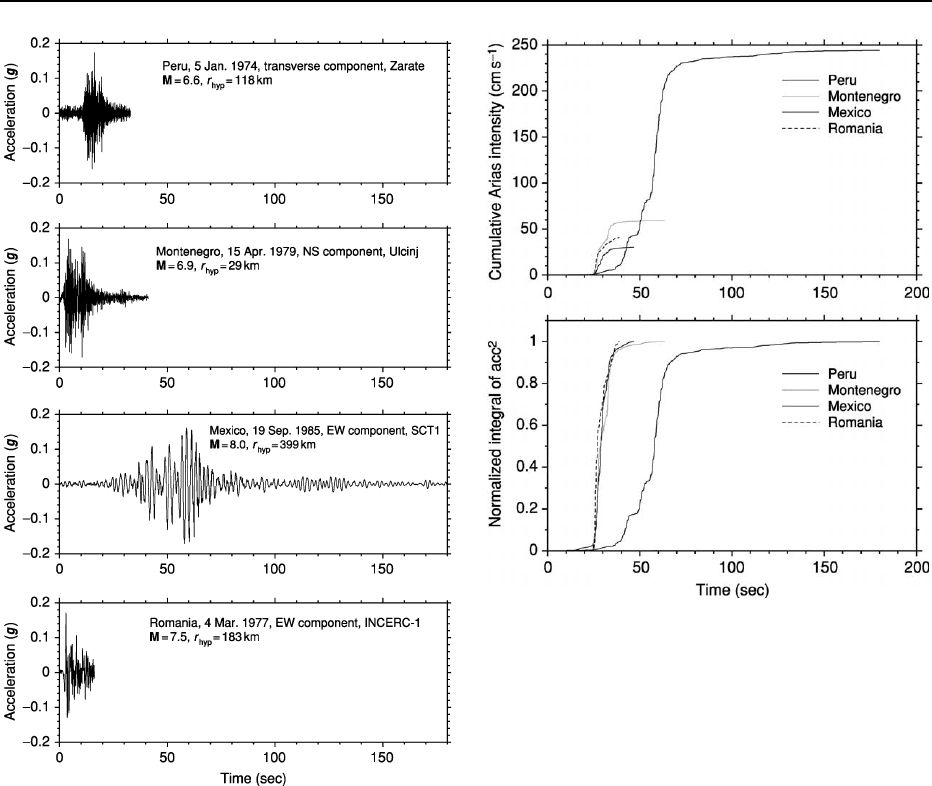
the assessment of liquefaction hazard because the
build-up of pore water pressures is controlled by
the number of cycles of motion as well as by the
amplitude of the motion.
A parameter that measures the energy content of
the ground shaking is the Arias intensity, which is
the integral over time of the square of the acceler-
ation. A plot of the build-up of Arias intensity with
time is known as a Husid plot (Figure 6) and it serves
to identify the interval over which the majority of
the energy is imparted. The root-mean-square acc-
eleration (a
rms
) is the equivalent constant level of
acceleration over any specified interval of the accel-
erogram; the a
rms
is also the square root of the gradi-
ent of the Husid plot over the same interval. Arias
intensity has been found to be a useful parameter to
define thresholds of shaking that trigger landslides.
For engineering purposes, the most important re-
presentation of earthquake ground motion is the
response spectrum, which is a graph of the maximum
response experienced by a series of single-degree-of-
freedom (SDOF) oscillators when subjected to the
acceleration time-series at their bases (Figure 7). The
dynamic characteristics of a SDOF system, such as
an idealized inverted pendulum, are fully described
by its natural period of free vibration and its
damping, usually modelled as an equivalent viscous
damping and expressed as a proportion of the critical
damping that returns a displaced SDOF system to
rest without vibrations. In earthquake engineering,
the default value generally used is 5% of critical
damping, the nominal level of damping in a re-
inforced concrete structure. The response can be
measured in terms of the absolute acceleration of
the mass of the system, or in terms of its velocity or
displacement relative to the base. The most widely
used spectrum currently is the acceleration response,
because the acceleration at the natural period of
the structure can be multiplied by the mass of the
building to estimate the lateral force exerted on the
structure by the earthquake shaking. The natural
period of vibration of a building can be very approxi-
mately estimated, in seconds, as the number of storeys
Figure 5 Four horizontal accelerogram components with
nearly the same peak ground acceleration. M, Moment
magnitude;
r
hyp
, distance from the hypocentre.
Figure 6 Husid plots for the four acceleration time-series
shown in Figure 5, showing the build-up of Arias intensity with
time. The upper plot shows the absolute values of Arias intensity;
in the lower plot, the curves are normalized to the maximum
value attained.
ENGINEERING GEOLOGY/Seismology 505
